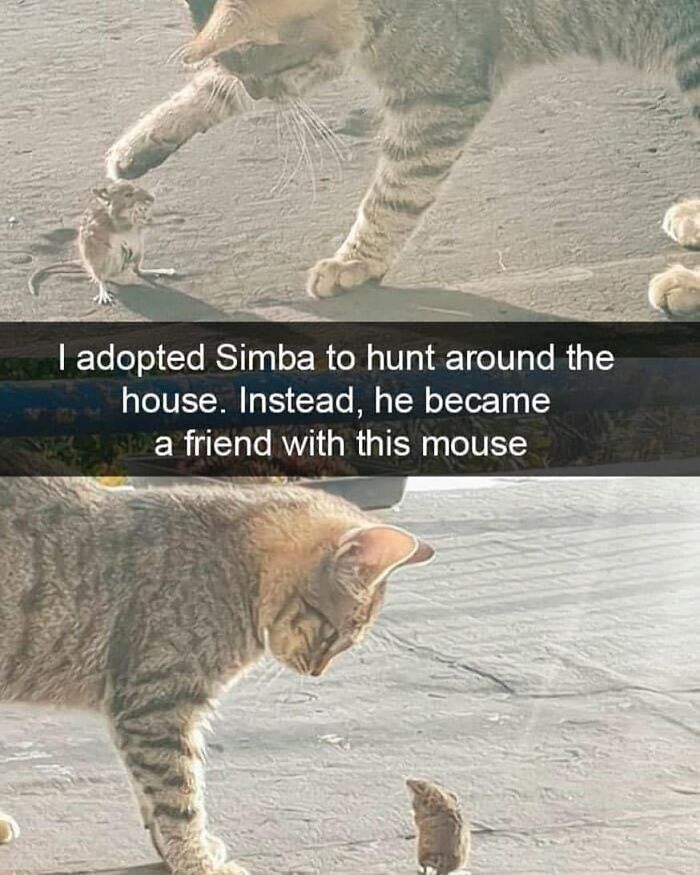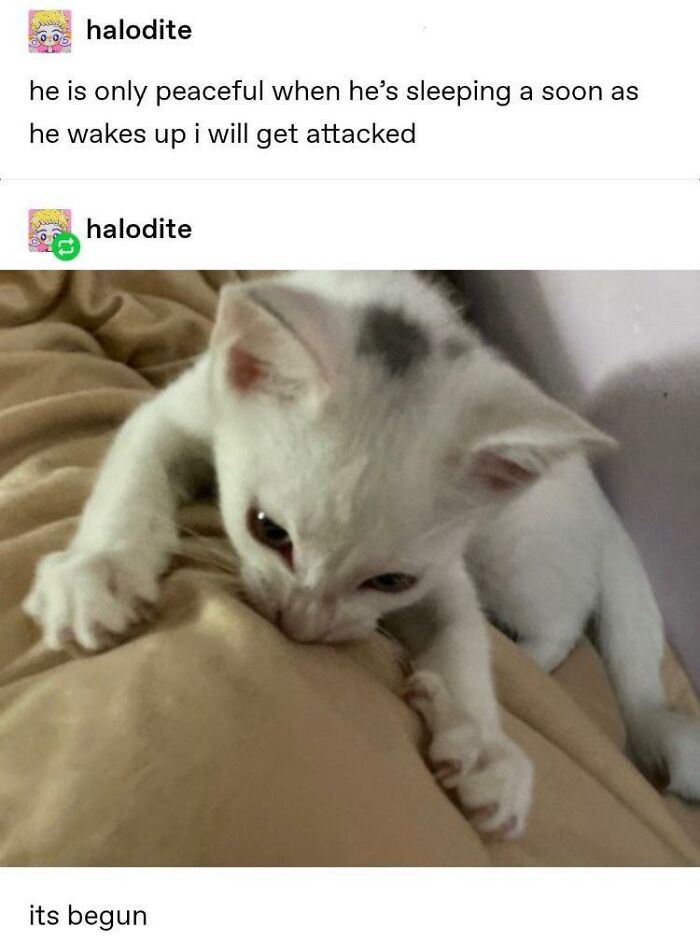There's no denying that people share a special bond with animals. From the loyal dogs that warmly greet us at the door to the self-reliant cats that proudly present us with their prey, these creatures have won us over and captivated our minds. Animals have a way of bringing joy into our lives, not just through their adorable antics but also their interesting and sometimes silly behavior.
What’s a better way to celebrate our beloved and funny creatures than by enjoying a collection of funny animal memes? Introducing “Smol Animal Memes”, a Facebook page capturing the hearts of more than 180 thousand followers. From funny animal faces forever captured in images to witty commentary, we’ve gathered some of the best posts for your enjoyment. Whether you're having a bad day or just need a good laugh, we believe that “Smol Animal Memes” will surely bring a smile to your face.
Don’t miss our exclusive interview with Sally Chamberlain, a clinical animal behaviorist who offers dog and cat behavior consultations and ‘Know Your Pet’ sessions, cat sitting services, cat training, preventive advice and education in cat behavior. Scroll down to learn more about challenges that pet owners might face, similarities between dogs and cats and more!
This post may include affiliate links.
Before delving into questions about animals and checking out the rest of these funny animal memes, we wanted to learn more about Sally Chamberlain and the driving force behind her pursuit of a career as a clinical animal behaviorist. The dog and cat behavior expert shared that she has always loved animals and bought her first cat behavior book when she was ten years old. “Back then, I had no idea that there was such a thing as a cat behaviorist, so learning about animal behavior was just a hobby. We had many pets in our family including cats, dogs, budgies, guinea pigs, hamsters and rabbits. I was also mad about horses and took up riding for a while.”
“As an adult, I had a series of office jobs that brought in some money but I never felt happy doing accounting work, so when I was looking for a part-time job after having my children, I decided to set up my own pet-sitting business. Looking after so many people and their pets inspired me to learn as much as I could about cats and dogs and after taking a few years to study for a degree-level qualification in animal behavior and gaining lots of experience, I was very happy to become an Accredited Animal Behaviourist in 2015 and a Clinical Animal Behaviourist in 2022, which was my ultimate goal!
I still enjoy caring for some long-established pet-sitting clients, but I also help people to resolve the cat and dog behavior problems in their household, remotely and in person, which is very rewarding but can sometimes be difficult, as it can often be stressful and emotional time for everyone involved. I wouldn’t swap it for the world, though, and I continue to learn more about canine and feline behavior every day, amongst other species.” You can learn more about Sally and her services on her website, Twitter, Facebook or Instagram!
It’s not that surprising that these funny animal memes mainly feature dogs and cats, as these creatures are among the most popular pets worldwide. While we usually hear how different they are in their behavior, we got curious about the similarities they share. Sally Chamberlain told us that cats and dogs are similar in many ways: “Both have evolved to live in domestic homes as pets (except certain dog breeds and some individuals) and can form strong bonds with their human caregivers. They are both opportunistic in the ways that they try to gain the most benefit from living with us, such as making sure they get the warmest seat in the house, are given tasty food and treats and do their best to solicit love and attention from us by being cute and affectionate. Most dogs get taken out for walks but some cats can enjoy walks in the same way if they are trained to do so, usually from a young age. Cats also enjoy playing games and some of them like to play ‘fetch’ in the same way that dogs do.”
“It is a long-held belief in human society that dogs are man’s best friend and cats are aloof, but the opposite can be true. I’ve met many cats with dog-like loyal qualities and dogs who can be aloof and would rather chomp on a chew in their beds or sniff around the garden than spend time with people. Cats and dogs are all very individual and although they are very different species, as modern-day pets, they can be similar in the way they have adjusted to life as domestic animals. A lot of households have both cats and dogs as pets and they can become closely bonded, especially if they are brought up together as puppies and kittens. Our own cat, Monty, has many dog-like qualities. He’ll often follow us around and flop on the floor nearby to watch what we are doing. He also enjoys lots of fuss and attention, including belly rubs, and really loves his food!”
Although pets can bring immense happiness and tons of funny animal pictures to their owners, they also present a range of challenges. Thinking about that, we asked Sally Chamberlain about some of the most common issues she has faced with pets and what tips she would suggest to help owners improve their pets’ behavior. According to the dog and cat behavior expert, one of the main issues that span both cats and dogs is a lack of understanding about how they communicate.
“Many humans assume that cats and dogs communicate in the same way as we do and like to be touched, hugged and looked in the eye and that they should be ‘told off’ when they do something wrong, but much of this can cause them anxiety. Animals such as cats and dogs rely heavily on scent as part of their communication systems so, especially in the case of feline behavior problems, they tend to urinate, defecate and spray urine around the home if they are feeling territorially secure but some humans believe they do this out of spite, when it is actually either due to a medical problem and/or anxiety. Another common behavior problem when it comes to cats is when their human caregivers bring another cat or kitten into the home and expect them to just get along. In most cases, cats do not like living with other cats, especially not unfamiliar ones and they will naturally try to expel them from their territory unless they are slowly and carefully introduced over a period of weeks or months.”
“Some of the most common canine behavior problems stem from them being poorly socialized as a puppy during what is referred to as the ‘sensitive period’ of around three to fourteen weeks of age. If they have not had positive experiences of different animals, people and places, they may struggle to cope with these later in life and behave aggressively or shut down because they are anxious and afraid. Another common issue with dogs, especially since lockdown in 2020, is separation anxiety, which means that a dog cannot cope with being left alone or even if they have human company, they cannot cope without their favorite person or people and may bark, whine, howl, urinate and defecate because they are so distressed. In some cases, dogs with severe separation anxiety have hurt themselves trying to break out of doors, windows or crates in an attempt to find their human families. Many dogs also struggle when out on walks and may pull on the lead, fail to come when called or bark and lunge at other dogs, people or passing vehicles or anything else with wheels. These are just a few of the examples of behavior problems in dogs and cats. There are many more but by learning as much as we can about cat and dog behavior and setting them up for success when they are young, much of them can be prevented.”
When it comes to animal training, dogs are often the first pets that come to mind. However, as many cat owners can attest, felines are also capable of learning and can benefit from training just like their canine counterparts. Just think, if you could train your cat to “smile” and how many funny animal faces memes you’d get out of it! According to Sally Chamberlain, any animal can be trained, and the principles are the same.
“The main type of training that most people are aware of is positive reinforcement training in which an animal is given a food treat or other reinforcer for carrying out an action that we would like them to. Dog training is well-known but cats can be trained in the same way if they are in the mood (calm and receptive) and a reinforcer of high enough value is used, such as small pieces of chicken, other food treats, play or fuss, depending on what they find rewarding. Training a dog is likely to be more well-known because they go out into public places more frequently than cats and there can be issues with the law and the risk of injury if a dog is not well-behaved in public. When it comes to cats, they too often go outside but are more likely to run away from someone rather than interact or behave aggressively. Training for cats can be enriching for them, reduce anxiety and increase the bond between them and their humans. Training is also good for getting them used to husbandry procedures, such as claw trimming or administering medication and can also form part of behavior therapy to resolve some of the problems mentioned above.”
“Training continually occurs in animals because they are always learning and we can shape their behavior by offering rewards when they do something we want and would like to be repeated, such as them lying down calmly or staying on a stool next to the kitchen worktop when we are cooking. This principle also applies to us too because, as you may have noticed, our cats and dogs have us very well trained! They train us to stroke them when they jump on our lap, give them food when they are hungry and open the door for them when they want to go out. Cats are especially good at training humans to get them to do what they want, hence the phrase ‘dogs have owners, cats have staff’!”
When it comes to training animals and communicating with them in general, Sally Chamberlain has some last words: "It is vital to remember that we should be kind and set them up for success by making the training easy at first and gradually building up to more complex exercises. Training with kindness and without the use of force, fear or intimidation is usually referred to as being ‘force-free’. I would recommend being very cautious about using any techniques shown on television shows, as these are often outdated and designed to show a ‘quick fix’ for entertainment purposes. Some of the best ways to learn about force-free training are the following YouTube channels, websites and books. These a just a few but are an excellent place to start:
‘Easy Peasy Doggy Squeezy’ by Steve Mann
To find a qualified behaviorist:
IAABC (America and rest of world)”
But for now, let’s go back to our list of funny animal memes that will make you laugh! After all, we could all do with a bit more positive emotions in our day.
i looked at this and my brain went "mEoW" and so basically i just meowed. out loud. at a dog picture. in a quiet room. full of people. i hate myself lmao
Coulda happened to any one of us pandas. Here's a 😺 for emotional support
Load More Replies...He'll still devour your soul, but he'll be polite about it and you may boop his snoot during the process
Haha. I had thr pleasure of meeting Drax the Destroyer; was such a sweet pup
Cats do this too? I thought it was only dogs O_O --- was told that cats eat sensibly.. only when they're hungry and stop when they're full. Am I living a lie?!
Hello there! just thought I come here to share my silly cat who stole my swing chair thing <3 unnamed-13...18b120.jpg 
I love ur cat, they look confused and it's adorable
Load More Replies...Hello there! just thought I come here to share my silly cat who stole my swing chair thing <3 unnamed-13...18b120.jpg 
I love ur cat, they look confused and it's adorable
Load More Replies...
 Dark Mode
Dark Mode 

 No fees, cancel anytime
No fees, cancel anytime 
























































































